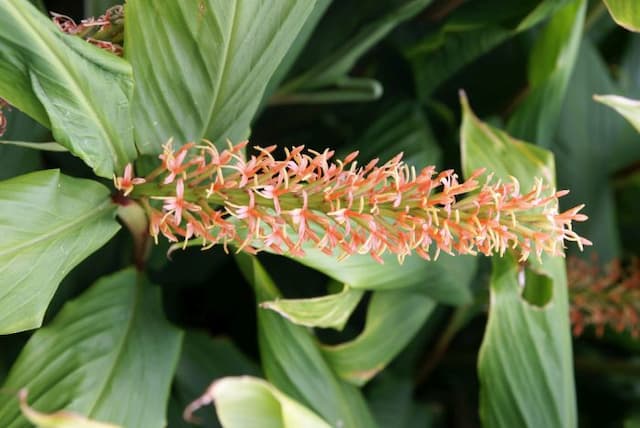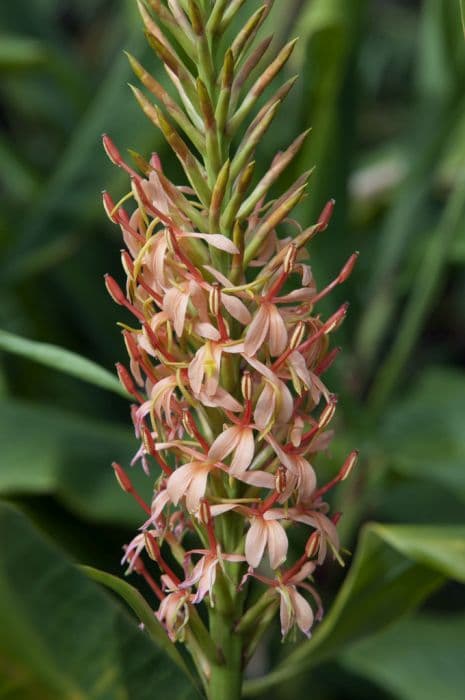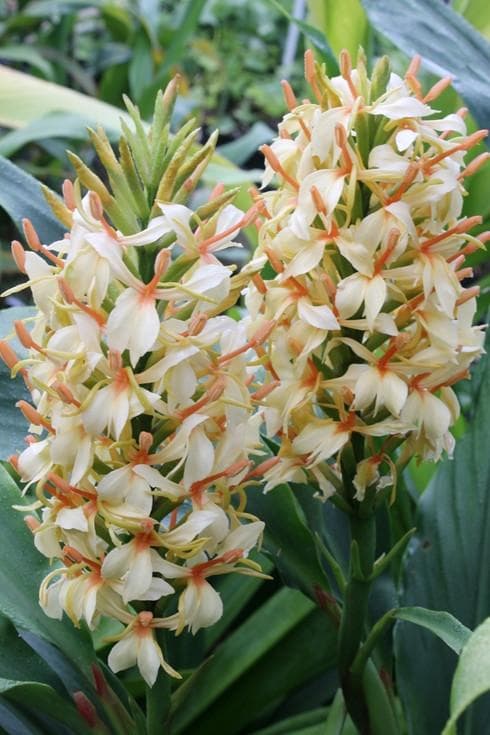Roscoea Roscoea 'Summer Deep Purple'

ABOUT
The Roscoea 'Summer Deep Purple' is a perennial plant noted for its striking floral and foliar characteristics. This plant features beautiful deep purple flowers which exhibit a typical orchid-like shape, emboldened by a rich hue that adds an exotic touch to gardens. The blooms are delicate yet showy, with a trumpet-like structure that draws attention. Surrounding the blooms are lance-shaped leaves that have a lush green color, providing a vivid contrast to the purple petals, and these leaves spread out gracefully from the base of the plant, creating an elegant foliage display. The combination of its vibrant green foliage and deep purple flowers makes the Roscoea 'Summer Deep Purple' a highly sought-after selection for ornamental purposes. Its overall appearance brings a tropical flair to temperate gardens, offering a splash of color and an element of sophistication to the landscape. While it is bred for ornamental use, it retains the resilient qualities typical of Roscoea genus, making it both a beautiful and practical addition to a variety of garden settings.
About this plant
 Names
NamesSynonyms
Summer Deep Purple Roscoea, Purple Dragonflower.
Common names
Roscoea 'Summer Deep Purple'.
 Toxicity
ToxicityTo humans
Roscoea 'Summer Deep Purple', commonly referred to as Roscoea, is not known to be toxic to humans. Therefore, there are no common symptoms of poisoning associated with ingestion of this plant's parts. It's always recommended to exercise caution and avoid ingesting plants that are not confirmed to be safe for consumption.
To pets
Roscoea 'Summer Deep Purple', simply known as Roscoea, is not recognized as toxic to pets. There are no typical symptoms of poisoning for this plant since it is generally considered safe for animals. Nonetheless, pet owners should be prudent and prevent pets from eating ornamental plants as a precautionary measure.
 Characteristics
CharacteristicsLife cycle
Perennials
Foliage type
Deciduous
Color of leaves
Green
Flower color
Deep Purple
Height
1-2 feet (30-60 cm)
Spread
0.5-1 feet (15-30 cm)
Plant type
Herb
Hardiness zones
6
Native area
Asia
Benefits
 General Benefits
General Benefits- Attracts Pollinators: Roscoea 'Summer Deep Purple' lures bees, butterflies, and other beneficial insects which help in pollination.
- Low Maintenance: This plant generally requires minimal upkeep, making it suitable for gardeners of all experience levels.
- Aesthetic Appeal: With its vibrant deep purple flowers, it adds a splash of color and exotic beauty to gardens.
- Drought Tolerance: Once established, it is fairly resilient to periods of low water, making it suitable for xeriscaped areas.
- Shade Tolerance: It can thrive in partial shade, allowing for versatile placement in the garden.
- Cold Hardy: This plant can survive in relatively cold climates, which makes it a good option for temperate gardens.
- Compact Size: It typically remains modest in size, so it fits well in smaller gardens or as part of border plantings.
 Medical Properties
Medical PropertiesThis plant is not used for medical purposes.
 Air-purifying Qualities
Air-purifying QualitiesThis plant is not specifically known for air purifying qualities.
 Other Uses
Other Uses- Artistic Inspiration: The vibrant purple blooms of Roscoea can inspire artists and can be used as a subject for paintings, sketches, and botanical illustrations.
- Photography Prop: Its striking appearance can be an excellent focal point for garden photographers looking to capture the beauty of unique flowers.
- Fragrance Extraction: Although not common, the delicate scent of the Roscoea flowers might be utilized in the creation of bespoke perfumes.
- Educational Tool: This plant can be used in schools or botanical gardens to educate individuals about ginger family species and plant biodiversity.
- Dye Source: The deep purple pigment of the flowers could potentially be used to create natural dyes for textiles and crafts.
- Ornamental Crafts: Dried Roscoea flowers could be used in making ornamental crafts such as bookmarks or pressed flower arrangements.
- Theme Gardens: Roscoea can be planted as part of a 'purple theme' garden or a monochromatic landscape design.
- Culinary Garnish: Though not a typical use, the petals could serve as an edible garnish, adding color to salads and desserts.
- Flower Festivals: The uniqueness of Roscoea's purple flowers allows them to be featured as a special exhibit in flower festivals and shows.
- Collectors' Item: Gardeners who specialize in collecting rare and exotic plants may cultivate Roscoea as a valuable addition to their collection.
Interesting Facts
 Feng Shui
Feng ShuiThe Roscoea is not used in Feng Shui practice.
 Zodiac Sign Compitability
Zodiac Sign CompitabilityThe Roscoea is not used in astrology practice.
 Plant Symbolism
Plant Symbolism- Royalty: The deep purple color of the flowers is often associated with nobility and majesty, symbolizing richness and opulence.
- Mystery: Purple can also be indicative of the mysterious or the enigmatic, sparking curiosity and a sense of the unknown.
- Spirituality: Purple hues have a historical association with spirituality and contemplation, potentially making this plant symbolic of deep thought and introspection.
- Dignity: The plant's stately appearance might convey a sense of dignity and pride, making it a symbol of self-respect.
- Transformation: As many plants bloom and change through the seasons, the Roscoea 'Summer Deep Purple' can also embody the theme of transformation and growth.
 Water
WaterFor Roscoea 'Summer Deep Purple', commonly known as Hardy Ginger, watering should be sufficient to keep the soil evenly moist but not waterlogged. Initially, after planting, water thoroughly to help establish the roots, which may require watering every few days. Once established, reduce watering frequency to approximately once a week, applying about one gallon of water per plant to saturate the root zone. During hot and dry weather, you may need to water more frequently, while in cooler, wetter conditions, you can water less often. Always check the soil moisture at about two inches depth; if it feels dry, it's time to water.
 Light
LightHardy Ginger prefers partial shade to full sunlight, thriving best when they receive morning sun and afternoon shade. An ideal spot would be under the canopy of taller plants or trees that offer dappled sunlight, protecting the leaves from the harsh afternoon sun. Ensure that the plant receives a few hours of direct sunlight daily, but avoid prolonged exposure to intense midday sun which can scorch the foliage.
 Temperature
TemperatureHardy Ginger does well in temperatures that range from 60°F to 80°F, which are typical for temperate climates during the growing season. They can tolerate a minimum temperature down to about 30°F; however, prolonged exposure to freezing temperatures can damage or kill the plant. Ideally, keep them in conditions that avoid extremes, providing a stable environment that does not fluctuate dramatically.
 Pruning
PruningPruning Hardy Ginger is necessary to remove any dead or yellowing leaves and to maintain a tidy appearance. It's best to prune in the late winter or early spring before new growth starts. Pruning can be done sporadically throughout the growing season as needed to remove damaged foliage. Cut back the foliage to ground level at the end of the blooming season to prepare the plant for winter.
 Cleaning
CleaningAs needed
 Soil
SoilGinger family Summer Deep Purple thrives in lightweight, well-draining soil with high organic matter content. A mix of two parts garden soil, one part perlite or sand, and one part well-rotted compost or leaf mold is ideal. Maintain a soil pH between 6.5 and 7.5 for optimal growth.
 Repotting
RepottingSummer Deep Purple should be repotted every 2 to 3 years, or whenever you notice that the plant has outgrown its current pot. The best time to repot is in the spring just before the new growth starts.
 Humidity & Misting
Humidity & MistingSummer Deep Purple prefers moderate humidity levels, typically around 50-60%. It's important to maintain consistent humidity without allowing the plant to sit in overly moist conditions that could lead to root rot.
 Suitable locations
Suitable locationsIndoor
Place in bright, indirect light with good air circulation.
Outdoor
Plant in partial shade with shelter from strong winds.
Hardiness zone
6-9 USDA
 Life cycle
Life cycleThe Roscoea 'Summer Deep Purple', commonly known as Summer Deep Purple Roscoea, starts its life cycle as a dormant rhizome, which begins to sprout in spring when the temperatures rise. New shoots emerge from the rhizome, developing into lush green foliage. By mid to late summer, the plant produces vibrant deep purple flowers that are a characteristic feature of this cultivar. Following pollination, which is often facilitated by insects, the plant may produce seed capsules if conditions are favorable. As autumn approaches, the above-ground foliage starts to die back, and the plant enters a period of dormancy during the winter months. Throughout this dormant period, the rhizome survives underground, storing energy for the next growing season.
 Propogation
PropogationPropogation time
Spring-Early Summer
The ideal time for propagating Roscoea 'Summer Deep Purple', commonly known as Hardy Ginger, is in the spring just before new growth begins. The most popular method of propagation for this plant is by division of its rhizomes. To propagate by division, carefully dig up the plant after the foliage has died back, which typically occurs in the fall. Gently separate the rhizomes, ensuring that each division has at least one growth bud. Replant the divisions at a depth of about 2 to 3 inches (5 to 7.5 centimeters), spacing them approximately 12 inches (about 30 centimeters) apart in well-draining soil. Water the newly planted divisions well to help establish them. It's important to maintain even moisture during the first growing season to encourage healthy root development.








